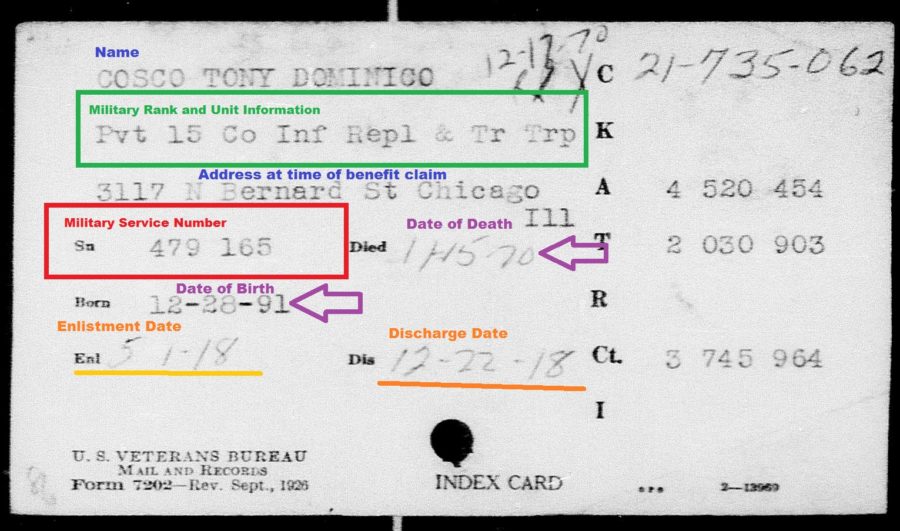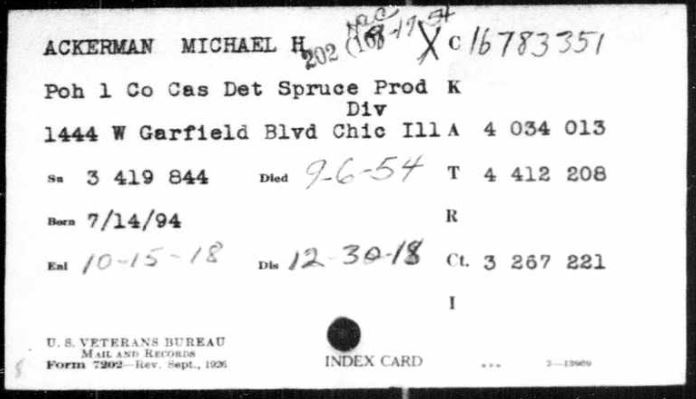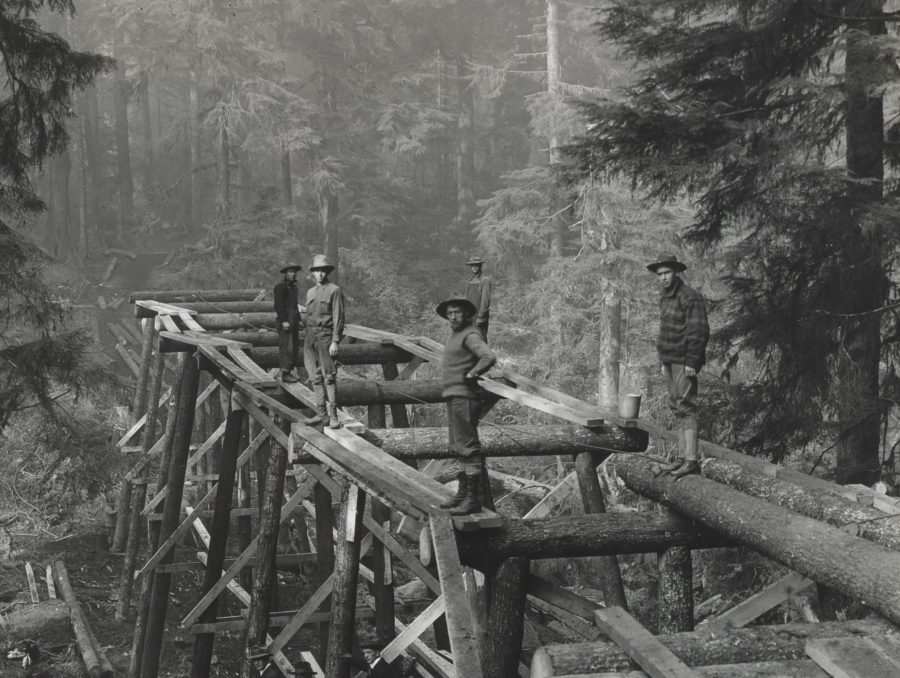Just within the past two years, a vast amount of Great War era records have gone online and were made searchable to researchers. This was in no small part due to the need to have more items available to commemorate the centennial of World War I. If you had a family story about an ancestor serving in Europe or Russia, a search of the National Archives’ newly digitized U.S. Army Transport Service passenger lists from 1910-1939 on Ancestry provided a breakthrough moment, as well as essential military service information to move forward with your research.
But what happens when your ancestor did not serve in Europe? What if they were undergoing basic training in a military camp? What about the people stationed in hospitals, depot brigades, development battalions or production divisions? How do you track down more details on these types of service?
In most instances, I would refer researchers to the growing collection of state resources, such as service cards, veterans bonus applications, veterans service questionnaires and World War honor books. This strategy works well for researchers with Great War ancestors in California, Connecticut, Georgia, Indiana, Kentucky, Louisiana, New York, Virginia and Texas, just to name a few.
Illinois, as well as states such as South Carolina, West Virginia and Wyoming, suffer from a distinct lack of readily available World War I records. In the case of Illinois, a fire in the St. Louis’s adjutant general’s office wiped out all of the state’s military service cards as well as some veteran bonus records. The only other option is to look for records on a county, city or federal level.
Federal level? Yes, federal records, which were easily attainable and usable, but not available online from the National Personnel Records Center outside St. Louis.
You might be thinking, “Weren’t all the World War I records burned in the National Archives fire in 1973?”
Nope. Not by a long shot.
One of the best records you could use to ascertain your ancestor’s World War I military service are the United States Veterans Administration Index Cards, which are beautifully intact and available in alphabetical order by name. No more puzzling over service branch or wondering if you have the right person. The VA Index Cards are a marvel, and more importantly, they have recently been digitized and made available online for free on FamilySearch.
There are two sets of Veterans Administration records you will want to refer to in your search for World War I military ancestors:
- United States, Veterans Administration Master Index, 1917-1940
- United States Veterans Administration Pension Payment Cards, 1907-1933
So, how do we use these cards to advance our research?
Let’s take a look back at those family stories and examine the information you have already collected on a World War I era ancestor. You may have a father, grandfather, great-grandfather, uncle or cousin who has a military headstone which simply reads “World War I” but no other information. An online hit on a genealogy website provides correct birth and death date information and enlistment dates in a Veterans Administration BIRLS (Beneficiary Identification Records Locator Subsystem) record. The 1930 US Federal Census lists a male ancestor as “Veteran – Yes, WW.” You found a World War I draft registration card, but you haven’t found them online in resources such as the U.S. Headstone Applications for Military Veterans, 1925-1963 or the U.S., Army Transport Service, Passenger Lists, 1910-1939 on Ancestry. All the state service cards for Illinois were destroyed. The family members you spoke with cannot provide details about your ancestor’s military service other than “I don’t remember,” or “They never talked about it.”
This experience may have left you feeling like grandpa or great-grandpa maybe didn’t serve in the military during the Great War, or if they did, they wouldn’t have a paper trail left to research. That’s where the Veterans Administration Index Cards can be used to successfully advance your research.
Case Study: Tony Dominico Cosco
Take the case study of Tony Dominico Cosco, born in Magisano, Italy on December 28, 1891. Tony immigrated to the US in 1909 and found work in a candy factory in Chicago. He has a World War I and World War II draft card on Ancestry, a BIRLS record and marked “Veteran – Yes, WW” on the 1930 US Federal Census. The research gathered is be coming into alignment, but there isn’t a solid description of unit/regiment information for him yet. Before the Veterans Administration Master Index became available online in 2019, an in-person visit or email request to the NRPC for Tony’s index card would have been required. Not any more.
Accessing the Veterans Administration Master Index and performing a search for Tony Dominico Cosco pulls up his military service information. Let’s take a look at his information details and piece together a picture of his Great War service details:

Using the National Archives list of World War I abbreviations, we can read Tony’s military service details as “Private – 15th Company Infantry Replacement and Transport” from May 1, 1918 through December 22, 1918. He was undergoing essential military training in anticipation of heading abroad.
For five months, Tony would have undergone basic military training, specialty training in rifle and artillery ranges, trench warfare and other skills as determined by camp administrators. When the Armistice went into effect on November 11, 1918, Tony’s situation changed significantly. He was discharged just before Christmas and headed back to Chicago. He wasn’t the only man to leave, as the military switched its focus from sending troops out of the country to bringing them home and back into civilian life.
Case Study: Michael Ackerman
Let’s look at another example. Michael Ackerman was the son of German immigrants. He moved to Chicago after the Great War and doesn’t have a draft card. The 1930 US Federal Census does not list him as a veteran, but he has a BIRLS record. Did he serve in WWI or not? His VA Index Card says yes, and it points in the direction of a fascinating field of research: the Spruce Production Division.

The Spruce Production Division was responsible for harvesting Sitka Spruce timber from the forests of the Pacific Northwest for the specific purpose of providing wooden aircraft for the US military. This was a time period in which Great War airplanes were little more than a wood frame, aluminum painted fabric, a metal engine and a wooden propeller. The division produced nearly 150 million feet of wood during its 15 months of operation, and in a move which proved controversial, their office ceased production almost as soon as the war was over.
Michael spent his two months of wartime service assisting in the collection of raw materials for wartime service production. His Illinois military service card is lost, but now there is a record online which can help fill in the hole left by the absence of Illinois records.

Soldiers building a Spruce Production Division railroad trestle in April, 1919. Photo from National Archives
Does the Veterans Administration Master Index collection on FamilySearch list every single World War I veteran? No, it certainly does not. But it is the largest and most reliable collection of records available for Great War researchers, as well as anyone interested in learning more about the service of family who participated in the Philippine-American War, Spanish-American War or the 1916 Mexican War. As these records are now online, discovering the basic details of an ancestor’s service will be quick and convenient undertaking. When I began researching Great War records in 2013, I had hoped these type of index cards would be digitized and searchable online.
With the Great War centennial winding down, now is the perfect time to research and discover this overlooked or difficult-to-research veterans. When you have spent some time researching your World War I military ancestors, don’t forget to submit their story of service on the World War I Centennial Commission website. The commission also has a free WWI Genealogy Research Guide available to request online and is delivered right to your email inbox. Easy peasy. You can also locate this guide through our digital collection or reserve a physical copy from our shelves.
If you are having problems locating information on your Great War ancestor, let me know. I’m always happy to help!
See you at the library!
